Ravana
Ravana(/ˈrɑːvənə/;[1]Sanskrit: रावण, IAST: Rāvaṇa, pronounced [ˈraːʋɐɳɐ]) is described as the demon king of Lanka in the ancient Sanskrit epic Ramayana and also in other ancient Hindu texts.[2][3][4]
| Ravana | |
|---|---|
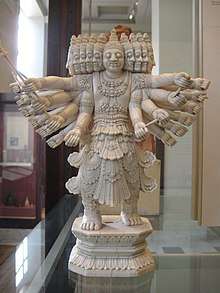 Statue of Ravana from the 18th century CE | |
| Raja of Lanka | |
| Predecessor | Kubera |
| Successor | Vibhishana |
| Spouse | |
| Issue | Indrajit, Atikaya, Akshayakumara, Narantaka, Devantaka, Trishira |
| Father | Vishrava |
| Mother | Kaikashi |
Ravana is widely considered to be a symbol of evil. While in Sri Lankan mythology, he is considered as a great ruler.[5] Ravana also had many qualities that made him a learned scholar. He was well-versed in the six shastras and the four Vedas.[6].
In the Ramayana, Ravana abducts Rama's wife Sita and took her to his kingdom of Lanka, where he held her as a prisoner in Ashok Vatika.[7] Furthermore in Ramayana, it is stated that during this time, he expressed desire to marry her. Later, Rama, with support of vanara King Sugriva and his army of vanars, attacked to Lanka, killed King Ravana, and rescued his beloved wife Sita[8].
Ravana is considered to be the most revered devotee of Shiva. Images of Ravana are seen associated with Shiva at some places. He also appears in the Buddhist Mahayana text Laṅkāvatāra Sūtra, in Buddhist Ramayanas and Jatakas, as well as in Jain Ramayanas. In some scriptures, he is depicted as one of Vishnu’s cursed doorkeepers.[9]
Etymology

The word Rāvaṇa (Sanskrit: रावण) means roaring opposite of Vaiśravaṇa meaning "hear distinctly" (passive).[10][11] Both Ravana and Vaiśravaṇa, who is popularly known as Kubera, are considered to be patronymics derived as "sons of Vishrava".[10][11][12][13]
Rāvana was a title taken on later by Dashānana, and it means "screamer" in Sanskrit (Ravana would sing hymns).[14] Further, roravana is Sanskrit for "loud roaring." In Abhinava Gupta's Krama Shaiva scripture, yāsām rāvanam is used as an expression to mean people who are truly aware in terms of the materialism of their environment.
Ravana has many other popular names, such as Dasis Ravana, Dasis Sakvithi Maha Ravana, Dashaanan, Ravula, Lankeshwar, Lankeshwaran, Ravanasura, Ravanaeshwaran, and Eela Vendhar.
Iconography
Ravana is depicted and described as having ten heads, although sometimes he is shown with only nine heads because he has sacrificed a head to convince Shiva. He is described as a devout follower of Shiva, a great scholar, a capable ruler and a maestro of the Veena (pronounced veh-nah; a chordophone instrument). Ravana is also depicted as the author of the Ravana Samhita, a book on Hindu astrology, and the Arka Prakasham, a book on Siddha medicine and treatment. Ravana possessed a thorough knowledge of Siddha and political science. He is said to have possessed the nectar of immortality, which was stored inside his belly, thanks to a celestial boon by Brahma.[15]
Depiction in the Ramayana
Birth
Ravana was born to great sage Vishrava (or Vesamuni), and his wife, the Rakshasa princess Kaikesi in the Treta Yuga. People of Bisrakh village in Uttar Pradesh claim that Bisrakh was named after Vishrava, and that Ravana was born there.[16] But according to Hela historical sources and folklore, Ravana was born in Lanka, where he later became king.
Ravana's grandfather on his father's side, the sage Pulastya,[17] was one of the ten Prajapatis or mind-born sons of Brahma and one of the Saptarishi (Seven Great Sages Rishi) in the first Manvantara (age of Manu). His maternal grandfather was Sumali (or Sumalaya); king of the Raksasas and the son of Sukesha. Sumali had ten sons and four daughters. Sumali wished Kaikeshi to marry the most powerful being in the mortal world, so as to produce an exceptional heir. He rejected the kings of the world, as they were less powerful than him. Kaikesi searched among the sages and finally chose Vishrava, the father of Kubera. Ravana and his siblings were born to the couple. They completed their education from their father, with Ravana being a great scholar of the Vedas.
Boon of Ravana
Ravana and his two brothers Kumbhakarna and Vibhishana performed penances on Mt Gokarna for 11,000 years and won boons from Brahma. Ravana was blessed with a boon that would make him invincible to the creation of Brahma, except for humans.[18] He also received weapons, chariot as well as the ability to shapeshift from Brahma. Ravana later usurped Lanka from his half-brother Kubera and became the King of Lanka. He appointed Shukracharya as his priest and learnt the Arthashastra (Science of Politics) from him.
Devotee of Shiva
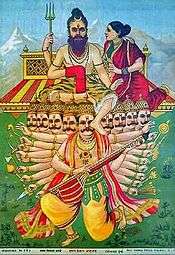
One of the most Popular Images of Shiva is called as "Ravananugraha" which was popular in gupta era which depicts Ravan beaneat Mount Kailasa Playing a Veena Made out of his head and hand and strings made out of his Tendons with Shiva Parvati sitting on top.[19] According to scriptures, Ravana once tried to lift Mount Kailash, but Shiva pushed the mountain into place and trapped Ravana beneath it. For a thousand years, the imprisoned Ravana sang hymns (Shiva Tandava Stotra) in praise of Shiva, who finally blessed him and granted him an invincible sword and a powerful linga (Shiva's aniconic symbol, Atmalinga) to worship.[20][19]
Family
Ravana's family are hardly mentioned outside the Ramayana, which is viewed by some as being only the point of view of Rama devotees. According to that:
- Ravana's granduncle was Malyavan, who was against the war with Rama and Lakshmana. He also had another granduncle named Mail who was killed by Lord Vishnu.[21]
- Ravana's parents were sage Vishrava (son of Pulastya) and Kaikesi (daughter of Sumali and Kethumathi). Kaikesi had ten brothers, the famous generals in Lanka’s army being Dhumraksha, Prahastha and Akampana, which would effectively make them Ravana's uncles and three aunties named Kumbinashi, Puspotkata, and Raka. Kaikesi’s father, Sumali was instrumental in making Ravana, the king of Lanka, by advising him to get boons from Brahma, defeat Kubera, and establish the Rakshasa rule in the three worlds.[22]
- Ravana had seven brothers and two sisters:
- Kubera – the King of North direction and the Guardian of Heavenly Wealth. He was an older half-brother of Ravana. Kubera was born to Vishrava's another wife Ilavida.
- Kumbhakarna – One of the most jovial demons in Hindu mythology. When offered a boon by Brahma, he was tricked into asking for eternal sleep. A horrified Ravana, out of brotherly love, persuaded Brahma to amend the boon. Brahma mitigated the power of the boon by making Kumbhakarna sleep for six months and being awake for the rest six months of a year (in some versions, he is awake for one day out of the year). During the war with Rama, Kumbhakarna was untimely awakened from his sleep. He tried to persuade Ravana to open negotiations with Rama and return Sita to him. But he too failed to mend the ways of Ravana. However, bound by a brother's duty, he fought on the side of Ravana and was killed in the battlefield. Before dying he met Vibhishana and blessed him for following the path of righteousness.
- Vibhishana – A follower of Rama and one of the most important characters in the Ramayana. As a minister and brother of Ravana, he spoke the truth without fear and advised Ravana to return the kidnapped Sita and uphold Dharma. Ravana not only rejected this sane advice, but also banished him from his kingdom. Vibhishana sought protection from Rama, which was granted without hesitation.
- Khara – King of Janasthan.[23] He was a cousin of Ravana and the son of Kaikesi's sister Raka.
- Dushana – Viceroy of Janasthan. Cousin of Ravana and twin brother of Khara.
- Ahiravan – In Krittivasi Ramayan, Ahiravan was king of the Underworld ruled by the rakshasas by Ravana and the demon king Maya.
- Kumbhini – Older half-sister of Ravana and the wife of the demon Madhu, King of Mathura. She was the mother of Lavanasura.
- Sahastra Ravana - He is mentioned in Adbhuta Ramayana as elder brother of Ravana, one thousand armed and thousand-headed, living on an island named Pushkar, he was much more powerful than his younger brother. He is slain by Sita who takes the form of Mahakali to slay him.[24]
- Shurpanakha – The sister of Ravana. She was the ultimate root of the kidnapping of Sita. She was the one who instigated her brothers to wage a war against Rama.
- Ravana was married to Mandodari, the daughter of the celestial architect Maya, Dhanyamalini, and a third wife. His sons from his three wives were as follows :
- Meghnaad (also known as Indrajit because he defeated Indra), the most powerful son of Ravana. He was born to Ravana's elder consort Mandodari.
- Atikaya
- Akshayakumara
- Narantaka
- Devantaka
- Trishira
- In the Bengali ballad "Meghnad Bodh Kavya" by Michael Madhusudan Dutt, Beerbahu is said to be Ravana's son.
Priestly ministers
Ravana is said in some version to have had Shukracharya, the priest of the Asuras, as his minister, and in some versions Brihaspati, the priest of the Devas.
One of the most original, which is not found in earlier manuscripts, tells how Ravana orders his court priest Brhaspati (all the gods being his slaves) to read the Chandi stava (mantras of Chandi), that is, the Devi Mahatmya, in order to stave off defeat if he can recite it. According to the Krttivasa text, Ravana arranged for a peaceful yajna (sacrifice) and to start the recitation of Chandi, Brihaspati was invited. Accordingly, Brihaspati recited the same correctly.[25]
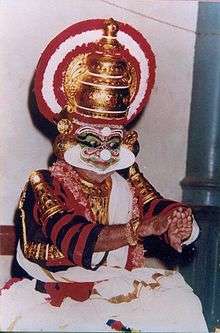
Depiction in other scriptures
As Vishnu's cursed doorkeeper
In the Bhagavata Purana, Ravana and his brother, Kumbhakarna, were said to be reincarnations of Jaya and Vijaya, gatekeepers at Vaikuntha, the abode of Vishnu and were cursed to be born in Earth for their insolence.
These gatekeepers refused entry to the Sanatha Kumara monks—- who, because of their powers and austerity, appeared as young children. For their insolence, the monks cursed them to be expelled from Vaikuntha and to be born on Earth.
Vishnu agreed that they should be punished. They were given two choices, that they could be born seven times as normal mortals and devotees of Vishnu, or three times as powerful and strong people, but as enemies of Vishnu. Eager to be back with the Lord, they choose the latter one. Ravana and his brother Kumbhakarna were born to fulfill the curse on the second birth as enemies of Vishnu in the Treta Yuga. The curse of first birth was fulfilled by Hiranyakashipu and his brother Hiranyaksha in Satya Yuga when they were both vanquished by earlier avatars of Vishnu (Hiranyaksha by Varaha and Hiranyakashipu by Narasimha) and the curse of third birth was fulfilled by Dantavakra and Shishupala in the Dvapara Yuga when they both were slain by Krishna, the eighth avatar.[9]
Conflict with other kings and Asuras
Ravana had gotten into a conflict with some other major Asuras.
- In Maheshwar, Madhya Pradesh is where he is said to have fought, but lost, to Kartavirya Arjuna, and he was tied up; later Kartavirya got the name Daśagrivajayi (the conqueror of Ravana just like Indrajit got his name by defeating Indra) and released him on the request of his grandfather sage Pulastya. Ravana vanquished.
- Marutta (Chakravarti King of Ushiraviga),
- Gadhi (Vishwamitra's father),
- Dushyanta (Bharata's father),
- Suratha (King of Vidarbha),
- Gaya (Chakravarti king of Dharmaranya), and
- Paurava (King of Anga).
- Ravana killed Anaranya, the king of Ayodhya although the latter cursed Ravana to be slain by Rama.
- Ravana was vanquished by the Ikshvaku King Mandhata, an ancestor of Rama.
- Ravana had wrestled his brother Kubera for the Pushpaka Vimana.
- In the Ramayana, he fought Vali the Kishkindha king, but was defeated by him.
- He also fought with the Nivatakavachas, the descendants of Prahlada, but being unable to defeat them, struck an alliance with them.
- Another time he was vanquished by the sage Kapila.
- One time, upon hearing a discourse from Sage Sanatkumara, Ravana attempted to invade Vaikuntha. Only Ravana managed to enter Vaikuntha's capital Shwetadwipa where he was hopelessly outmatched by the inhabitants over there and was forced to retreat.
Worship and temples
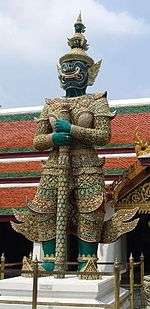
Worship
As he is considered one of the most revered devotees of Shiva, Ravana is worshiped in several places.[6] There are some Shiva temples where Ravana is worshiped.[27][28][29]
The Kanyakubja Brahmins of Vidisha district worship Ravana; they personify him as a symbol of prosperity and regard him as a saviour, claiming that Ravana was also a Kanyakubja Brahmin. Thousands of Kanyakubja Brahmins of the village Ravangram of Netaran, in the Vidisha District of Madhya Pradesh, perform daily puja (worship) in the Ravan temple and offer naivedyam / bhog (a ritual of sacrifice to the Gods). Centuries ago King Shiv Shankar built a Ravana temple at Kanpur, Uttar Pradesh. The Ravana temple is opened once a year, on Dashehra Day, to perform puja for the welfare of Ravana.[30]
Ravana also worshiped by Hindus of Bisrakh, who claim their town to be his birthplace.[31]
The Sachora Brahmins of Gujarat also claim to descend from Ravana, and sometimes have "Ravan" as their surnames.[32]
Some Saraswat Brahmins from Mathura claim Ravana as a saraswat brahmin as per his lineage.[33][34]
There is also reference to "Ravani", lineage of Upadhyaya Yasastrata II, who was of the Gautama gotra and was a son of Acharya Vasudatta, and described as "born of Ravani".[35]
The Gondi people of central India claim to be descendants of Ravana, and they also have temples set up for him, his wife Mandodari, and their son Meghnad. They also state that Ravana was an ancient Gond king, and the tenth dharmaguru of their tribe. Every year on Dussehra, the Gondis of the village of Paraswadi carry an image of Ravana riding on an elephant in a procession[36]
Temples
There are a number of temples in India for Ravana
- Dashanan Temple, Kanpur, Uttar Pradesh[37]
- Ravana Mandir, Bisrakh, Greater Noida, Uttar Pradesh[37]
- Kakinada Ravana temple, Andhra Pradesh[37]
- Ravangram Ravana Temple, Vidisha, Madhya Pradesh[37]
- Mandsaur, Madhya Pradesh[37]
- Mandore Ravan Temple, Jodhpur[38]
- Baijanath Temple, Kangra district, Himachal Pradesh[38]
Influence on culture and art
A Ramleela actor wears the traditional attire of Ravana. One of the most important literary works of ancient India, the Ramayana has had a profound impact on art and culture in the Indian subcontinent and Southeast Asia.[39]
Ravana-Dahan (burning effigy of Ravana)
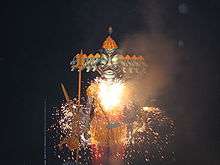
Effigies of Ravana are burned on Vijayadashami in many places throughout India. It is said that this symbolises Rama's triumph over evil (i.e., Ravana).[40]
Ravanahatha
The ancient instrument known as a ravanahatha is said to have belonged to a sovereign in present-day India around 5000 BC. It replicates the ancient instrument called the Ravan hatta which is found even today in Rajasthan. Mythology credits this creation to Ravana.[41]
Texts attributed to Ravana
Astronomy
There are also texts attributed to Ravana. The Ravan Samhita is an astrological text or scripture narrated by Shiva and written by Ravana.
Medicine
The Ravanakumara Tantra is a part of the tantric rituals of the Kriyakalagunottara Tantra,[42] and it is an 11th-century Sanskrit work for the treatment of children's diseases. It is also known as the Ravanaproktabalacikitsasutra ("Sutra Spoken by Ravana on the Curing of Children's Diseases").
Ravana appears as the composer of the 16th century C.E. text, Arka Prakasa, which is a dialogue between the king of Lanka and his wife Mandodhari about which herbs and chemicals can be used in a mixture to cure illnesses, such as syphilis.
Ravana is also the composer of the 16th century C.E. scriptures Nadi Pariksa and Nadi Vijnana on knowledge about the veins.
Linguistics
Ravana is the composer of the Ravanabhet, a Vedic text on the phonetics of the Sanskrit language.
Ravana is also the composer of the Ravaniya, also known as Ravanabaith, a text on the phonetics of the Telugu language.
The Prakrta-Kamadhenu grammatical text on the Prakrit language is attributed to "Ravana Lankesvara".
Spirituality
The Samkhya scripture known as the Ravana-bhasya, also known as Ravanabhasya, is believed to be written by Ravana.
The Vaisesika scripture Katandi (a commentary on the Vaisesika Sutra) is attributed to Ravana.
Ravana is also the name used by a commentator of the Shaiva Rudrapurascharana.
"Ravanacharya" is the scholar who wrote the Padaratna, a commentary on the Rig Veda.
Ravana is the composer of the Shavite scripture Shiva Tandava Stotram.
Alternate Ramayanas
Buddhist versions
Rama is always the protagonist. In Rin-spuns-pa Tibetan Ramayana, it is prophesied that "Ravana" will return as the Buddha incarnation of Vishnu in the Kali Yuga.
The Tai Khamti Ramayana (Phra Chow Lamang) of Arunachal Pradesh as well describes Rama as a Bodhisattva incarnated to get tortured by Ravana.
In the Laotian Buddhist text Phra Lak Phra Lam, Rama is a Bodhisattva and the embodiment of virtues, while Ravana is a Brahmin ("mahabrahma") son of Virulaha who is highly materialistic.
In the Cambodian Buddhist text Preah Ream, Buddha is an incarnation of Rama and Ravana. He is a rakshasa.
In the Thai Buddhist text Ramakien, Rāvana is a rakshasa.[43] There, he is instead known as "Thotsakan" (ทศกัณฐ์, from Sanskrit दशकण्ठ, Daśakaṇṭha, "ten necks"), and he is depicted with green skin.
In the Lankavatara Sutra, Gautama Buddha pays a visit to Lanka, and in the scripture he is addressed as a Rakshasa. He is normally identified as a demon.
In the Karandavyuha Sutra, the god Yama asks if the visitor in hell (Avalokitesvara) whom he hasn't seen yet is a god or a demon, and asks whether he is Vishnu, Mahesvara, or the rakshasa ("demon") Rama.
Jain version
Jain accounts vary from the traditional Hindu accounts of Ramayana. The incidents are placed at the time of the 20th Tirthankara, Munisuvrata. According to Jain version, both Rama as well as Ravana were devout Jains.[44] Ravana was a Vidyadhara King who had magical powers.[45] Also, as per the Jain accounts, Ravana was killed by Lakshmana and not Rama in the end.[46]
Dravidian movement
Pulavar Kuzhanthai’s Ravana Kaaviyam, is a panegyric on Ravana. The book is made of 3100 poetic stanzas in which Ravana is the hero. The book was released in 1946. The book was banned by the then congress state government. The ban was lifted only in 1971.[47][48]
Depictions in Popular Culture
Films and Television
Films
| Films | Played by |
|---|---|
| Rambaan | Chandra Mohan |
| Sampoorna Ramayanam (1958 film) | T. K. Bhagavathi |
| Sampoorna Ramayana | B. M. Vyas |
| Seeta Rama Kalyanam | N. T. Rama Rao |
| Indrajeet (Sati Sulochana) | S. V. Ranga Rao |
| Sita Kalyanam (1976 film) | Kaikala Satyanarayana |
| Bajrangbali (film) | Prem Nath |
| Sri Rama Pattabhishekam | N. T. Rama Rao |
| Ramayana: The Legend of Prince Rama | Amrish Puri (voice) |
| Ramayanam (1996 film) | Swathi Baalineni |
| Raavanan | Vikram (Based on Ravana's character) |
| Ramayana: The Epic | Ashutosh Rana (voice) |
Television
| TV Series | Played by | Channel | Country |
|---|---|---|---|
| Ramayan (1987 TV series) | Arvind Trivedi[50] | DD National | India |
| Bharat Ek Khoj | Om Puri[51] | DD National | |
| Jai Hanuman (1997 TV series) | Anil Yadav | DD Metro | |
| Vishnu Puran | Nimai Bali | Zee TV DD National | |
| Ramayan (2002 TV series) | Surendra Pal | Zee TV | |
| Raavan (2006)[52] | Narendra Jha | Zee TV | |
| Ramayan (2008 TV series) | Akhilendra Mishra[53] | NDTV Imagine | |
| Jai Jai Jai Bajrang Bali | Nimai Bali | Sahara One | |
| Devon Ke Dev...Mahadev | Tarun Khanna[54] | Life OK | |
| Ramayan (2012 TV series) | Sachin Tyagi | Zee TV | |
| Ramleela – Ajay Devgn Ke Saath | Aman Verma | Life OK | |
| Siya Ke Ram | Karthik Jayaram[54] | Star Plus | |
| Sankatmochan Mahabali Hanuman | Aarya Babbar /Saurav Gurjar |
Sony Entertainment Television | |
| Vighnaharta Ganesha | Paras Chhabra[53] | Sony Entertainment Television | |
| Ram Siya Ke Luv Kush | Shalin Bhanot | Colors TV | |
| Ravana | Januka Rajapaksha | TV Derana | Sri Lanka |
See also
References
Notes
Citations
- "Ravana". Random House Webster's Unabridged Dictionary.
- James Talboys Wheeler. The History of India Vol.2, from the Earliest Ages: The Rámáyana and the Brahmanic Period. N.TRUBNER & CO. p. 281.
- Nathan Robert Brown. "The Mythology of Supernatural: The Signs and Symbols Behind the Popular TV Show". books.google.co.in. Berkley Boulvard books, Newwork. Retrieved 12 May 2020.
- "Ravana". britannica.com. Retrieved 12 May 2020.
- Bains, Grace (30 September 2017). "A Demon For Us But A Hero For Sri Lankans, The Fascinating Story Of Ravana, According To Lanka". www.scoopwhoop.com. Retrieved 4 July 2020.
- "Greatest Devotee of Shiva: Ravana, His Faith on Bhagwan Shiv". haribhakt.com. Retrieved 11 May 2020.
- "Sunderkand_Explanation" (PDF). sunderkandsatsangsamuh.org. Retrieved 12 May 2020.
- Das, Subhamoy. "The Ramayana: Summary by Stephen Knapp." Learn Religions". Retrieved 12 May 2020.
- "Where Ravana is Vishnu's True Bhakta". The Statesman. 31 July 2019. Retrieved 1 July 2020.
- Aiyangar Narayan (1909) "Essays On Indo-Aryan Mythology-Vol.", p.413
- "Cologne Scan". www.sanskrit-lexicon.uni-koeln.de.
- "The Rāmāyaṇa of Vālmīki: An Epic of Ancient India. Ayodhyākāṇḍa". Motilal Banarsidass Publishe. 25 April 2007 – via Google Books.
- Hopkins, Edward Washburn (1915). Epic mythology. Strassburg K.J. Trübner. p. 142.
- Ramayana By William Buck, Barend A. van Nooten, Shirley Triest
- Ramayana By Valmiki; Ramcharitmanas by Tulsidas (Lanka Kanda Vibhishana & Rama Samvaad)
- DelhiOctober 10, Prabhash K. Dutta New; October 10, 2016UPDATED:; Ist, 2016 18:29. "Did you know? Ravana was born in Greater Noida West". India Today. Retrieved 2 July 2020.CS1 maint: extra punctuation (link) CS1 maint: numeric names: authors list (link)
- Rajarajan, R.K.K. (2018). "Woven Threads of the Rāmāyaṇa The Early Āḻvārs on Brahmā and Rāvaṇa". Romanian Journal of Indian Studies. 2: 9–45.
- Manglik, Reshu (29 September 2017). "Happy Dussehra 2017: 11 important facts to know about Ravana, primary antagonist of epic Ramayana". www.indiatvnews.com. Retrieved 14 July 2020.
- Kala pp. 38–42
- "Know the unique story of Ravana's devotion to Shiva". News Track. 29 June 2020. Retrieved 14 July 2020.
- Mittal, J. P. (2006). History Of Ancient India (a New Version) : From 7300 Bb To 4250 Bc,. Atlantic Publishers & Dist. ISBN 978-81-269-0615-4.
- Mittal, J. P. (2006). History Of Ancient India (a New Version) : From 7300 Bb To 4250 Bc,. Atlantic Publishers & Dist. ISBN 978-81-269-0615-4.
- "History Hindus". Archived from the original on 9 August 2011.
- https://www.speakingtree.in/allslides/super-shocking-how-sita-saved-rama-and-killed-greater-ravana
- Genesis and Evolution of the Rāma Kathā in Indian Art, Thought, Literature, and Culture: From the Earliest Period to the Modern Times, Volume 2 By Shanti Lal Nagar
- Māni Mādhava Chākyār (1996). Nātyakalpadrumam. Sangeet Natak Akademi, New Delhi. p. 6.
- Ravana has his temples, too. The Sunday Tribune – Spectrum. 21 October 2007.
- Vachaspati.S, Ravana Brahma [in English], 2005, Rudrakavi Sahitya Peetham, Gandhi Nagar, Tenali, India.
- Kamalesh Kumar Dave, Dashanan [in Hindi], 2008, Akshaya Jyotish Anusandan Kendra, Quila Road, Jodhpur, India.
- Siddiqui, Faiz (10 October 2016). "A temple where demon king has his day". The Times of India. Retrieved 14 September 2018.
- "Only the elderly come to mourn Ravana in 'birthplace' Bisrakh". The Indian Express. 4 October 2014. Retrieved 14 June 2016.
- People of India: A - G., Volume 4. Oxford Univ. Press. p. 3061.
- "Mathura lawyer seeks ban on burning of Ravana effigies". 26 September 2017.
- AgraOctober 12, Siraj Qureshi; October 12, 2016UPDATED:; Ist, 2016 17:33. "A Dussehra without burning Ravana: This Brahmin community in Agra wants an end to practice". India Today.CS1 maint: extra punctuation (link) CS1 maint: numeric names: authors list (link)
- Indian Culture: Journal of the Indian Research Institute, Volume 15 By I.B. Corporation
- Celebrating Ravan, The Hindu
- "Five temples of Ravana in India where demon king is worshipped". India TV. 11 October 2016.
- "Unique Ravana Temples in India". Native Planet. 27 April 2018.
- "Celebrate the festive season by catching Ram Leela in these locations". Times of India Travel. Retrieved 1 July 2020.
- "Dussehra 2018: What Is The Significance Of Ravana Dahan". NDTV.com. Retrieved 1 July 2020.
- The Island (9 March 2008). "Sri Lankan revives Ravana’s musical instrument".
- The Alchemical Body: Siddha Traditions in Medieval India By David Gordon White
- Vyas, Lallan Prasad. Prachi Darshan. p. 98.
- Sharma, S.R. (1940), Jainism and Karnataka Culture, Dharwar: Karnatak Historical Research Society, p. 76
- Dalal, Roshen (2010), Hinduism: An Alphabetical Guide, India: Penguin Books, p. 338, ISBN 9780143414216
- Ramanujan, A.K. (1991), "Three hundred Rāmāyaṇas: Five examples and Three thoughts on Translation", in Paula Richman (ed.), Many Rāmāyaṇas: The Diversity of a Narrative Tradition in South Asia, University of California Press, p. 35, ISBN 978-0-520-07589-4
- M.S.S. Pandian (2 November 1998). "Ravana As Antidote". Outlook India. Archived from the original on 2018. Retrieved 20 June 2019.
- "Censorship of Dravidian Voices". April 2006. Archived from the original on 8 January 2018.
- Yamunan, Sruthisagar. "Why Sri Lanka named its first-ever satellite after Ravana". Scroll.in. Retrieved 2 July 2020.
- "Arvind Trivedi Did Not Want to Play Ravan in Ramayan But This Veteran Actor Convinced Him". News18. 21 April 2020.
- Jain, Madhu (30 September 1988). "Bharat Ek Khoj: The making of most extravagant serial ever". India Today.
- "Zee TV enters new genre with 'Ravan' on Saturdays at 9". Indiantelevision.com. 16 November 2006.
- "These actors who played Raavan role in Ramayana". News Track. 11 April 2020.
- "Ravan number 1: Why these actors would play Ravan over Ram anyday | Delhi News - Times of India". The Times of India.
Bibliography
- Doniger, Wendy (1993), Purana Perennis: Reciprocity and Transformation in Hindu and Jaina Texts, SUNY Press, ISBN 9780791413814
- Udayakumar, S.P. (2005). "Presenting the Past: Anxious History and Ancient Future in Hindutva India". Greenwood Publishing Group. Cite journal requires
|journal=(help)
External links
| Wikimedia Commons has media related to Ravana. |
| Wikiquote has quotations related to: Ravana |
| Preceded by Kubera |
Emperor of Lanka | Succeeded by Vibhisana |

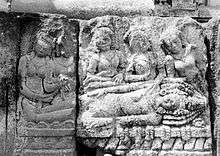
.jpg)